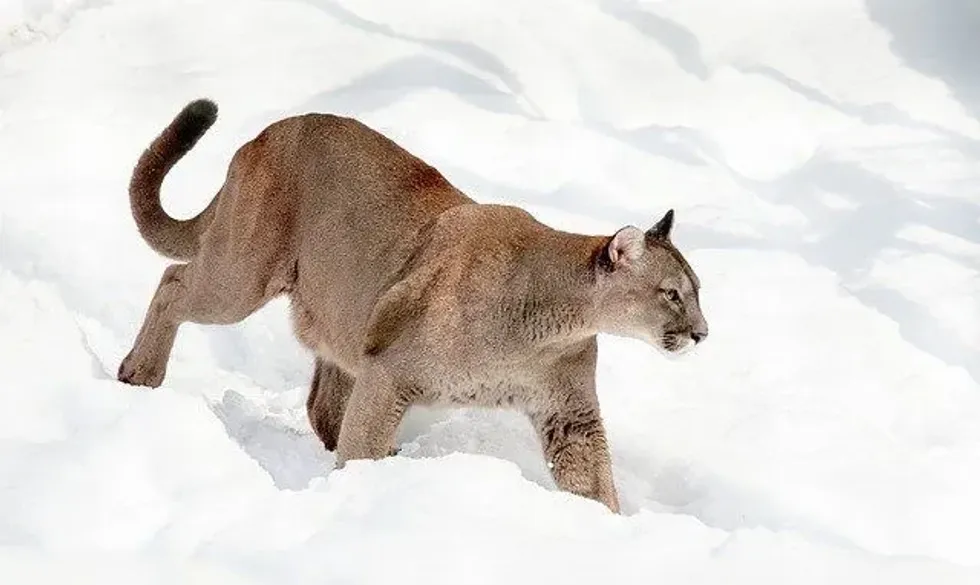You may know these felines by many names such as panther, cougar, puma, painter, catamount, and even mountain lion! These large cats are spotted mainly in North and South America. These beautiful wild animals come just behind jaguars for being the largest New World cats.
Stealth, secrecy, and solitude - mountain lions are known for these characteristics. Their lifestyles can be classified as being crepuscular and nocturnal, however, you might spot them during the day as well.
In the Western Hemisphere, cougars are the most widespread of all large terrestrial wild mammals. They are the fourth largest of all cat species. The mountain lion's size is smaller near the equator, however, they have larger bodies as their locations go nearer the poles.
Enjoying reading about the mountain lion? You can check out the tamandua and the Masai giraffe as well.
Mountain Lion Interesting Facts
What type of animal is a Mountain Lion?
The mountain lion, also known as a panther, is a member of the cat family.
What class of animal does a Mountain Lion belong to?
Mountain lions belong to the class Mammalia.
How many Mountain Lions are there in the world?
A rough estimate of about 50,000 mountain lions is currently surviving in the world.
Where does a Mountain Lion live?
Mountain lions are usually found in mountains and forests.
What is a Mountain Lion's habitat?
As these wild lions prefer to attack with an ambush, they desire habitats that have dense vegetation, or rocky areas which would help them for stalking their prey.
These mountain lions are found everywhere in North America, Central America as well as South America. The mountain lion's habitat extends from the Yukon Territory in Canada to the subtropical region of South America. The appearance of this species is more prominent on the western side of the United States.
Who do Mountain Lions live with?
Mountain lions usually prefer living alone.
How long does a Mountain Lion live?
The mountain lion's lifespan is about 20 years.
How do they reproduce?
The female mountain lion cougar reaches sexual maturity at around the age of one and a half to three years. The mating between mountain lions occurs throughout the year. The pregnancy of the females usually goes up to three months. Usually, the little cubs are born between July and September.
They give birth to their litter once every year or two, up to six cubs are born in each litter, but usually, it is just two little cubs born. These wild little cubs are completely dependent on their mother as they are born blind.
As they grow slowly, they gain their vision and begin visiting the hunting sites with their mothers, and around the age of six months, they begin hunting small prey themselves.
What is their conservation status?
The conservation status of the panther is of Least Concern, however, they are close to being endangered.
Mountain Lion Fun Facts
What do Mountain Lions look like?
They have a plain fur coat which usually is of one color. Their scientific name, Puma concolor, holds the Latin term ‘concolor’ which translates to ‘a single hue’.
Their bodies are usually silvery-grey in color, tawny or even slightly golden-tanned, with light spots on their jaws, throat, chin as well as underbody. Mountain lions in the United States are usually of a golden tan hue.
The puma has a small round head, and a small face with round, pointed ears. Their bodies are long, elegant, and sleek.
They have flexible necks and strong jaws to get a good grip on their prey. They have large front feet with five claws on each paw, and four claws on each hind paw. These claws can retract as per the cougar’s wish.
The little cougar babies are usually born with rings down their tails and blue eyes. Their bodies are spotted. As they grow older, they turn paler and their eyes slowly turn yellow.
Cougars are comparatively less muscular and not as powerful as their fellow felines, the jaguars. They have very powerful legs which can help them pounce and attack their prey easily.
How cute are they?
We find this species extremely cute.
How do they communicate?
Mountain lions surprisingly do not roar! They have a distinct cry. They are usually silent and have very little communication within their families. Just like domestic cats, they are known to communicate through low hisses, purrs, and growls. Pumas also purr, meow, and whistle to voice themselves.
How big is a Mountain Lion?
Adult mountain lions have a height of about 24-35 in (61-89 cm) at the shoulders. The Adult male panthers are about 7.9ft (2.4 m) long, accounting for the height from the nose to the end of the tail.
On the other hand, the length of the female panthers varies from 4.9-9 ft (1.5-2.74 m), including the tail lengths. Their tails alone are 25-37 in (0.63-0.94 m) long.
This wild lion is 1.2 times the height of an adult Dobermann. The length of mountain lions is almost twice that of a Dobermann.
How fast can a Mountain Lion run?
Mountain lions can run at speeds of up to 30 mph (48.3 kph)!
How much does a Mountain Lion weigh?
Adult male mountain lions have an average weight of 150 lb (68 kg), with the actual ranges varying between 117-220 lb (53-100 kg). The females weigh between 64-141 lb (29-64 kg), which averages out to 121 lb (55kg).
What are the male and female names of the species?
Male mountain lions are called toms, whereas the females are known as queens.
What would you call a baby Mountain Lion?
A baby mountain lion is called a cub or a kitten.
What do they eat?
Mountain Lions are smart predators - they do not attack straight away, but instead, follow the sit-and-wait strategy to attack their prey. Mountain lions will eat any prey they get their paws on. Ungulates are their prime prey, such as deer, zebras, and elk.
They also feed on large insects, rabbits, and rodents. Mountain goats, coyotes, horses, and sheep are also hunted by mountain lions as they need to feed on meat to survive. Deer is one of the favorites of the mountain lion diet.
Some cats of this family are also known to have fed on quills and porcupines without facing much trouble!
Are they slobbery?
No, this species does not slobber much.
Would they make a good pet?
We do not recommend them as a good pet as they might attack you anytime! As well as this, they are wild animals and should be left alone in their habitat.
Did you know...
Though these felines are pretty dangerous, their lives are endangered due to various wild predators. Their populations are constantly declining by being predated by large brown bears. Though mountain lion is powerful against a wolf and a coyote, they are not capable of fighting large packs alone.
This lion is super territorial but avoids human interference. However, they might attack humans if found alone.
The early explorers from Spain spotted this species in North and South America, and have called this animal ‘leon’, which translates to ‘lion’, as well as ‘gato monte’, which means ‘the cat of the mountain’, hence giving this cat the English name - mountain lion.
The cougars can jump to a height of 18 ft (5.5 m) from the ground up to the tree branches. They are also able to jump up to 20 ft (6.1 m) long - almost the height of the tip of an adult giraffe or a two-story building!
What to do if you happen to pass by their habitat and spot a panther? Speak loudly and make noises to startle them.
Lock eyes with them and stand firm, looking confident and fierce. Try waving your hands in the air and appear tall. Never attempt to run away, because you never know when they might attack you from behind.
What does a Mountain Lion sound like?
Mountain lion sounds have different meanings. They have been said to make soft chirping sounds that resemble a human’s whistle or the chirps of birds.
Such a call is made usually when the queen is in search of her little cubs who are out hunting. Such calls are also known to confuse their prey, who assume them to be harmless birds. Such tactics help the panther get their prey easily.
During the breeding season, the females make high pitch noises.
This species usually growl to express their aggression or if they feel threatened.
What is the difference between a cougar and a mountain lion?
Cougars and mountain lions are the same species! The only difference is their names, which differ according to the geographical locations they are used in. There is no difference between these two animals.
Here at Kidadl, we have carefully created lots of interesting family-friendly animal facts for everyone to discover! Learn more about some other mammals including the Cuban solenodon and the mountain zebra.
You can even occupy yourself at home by drawing one of our mountain lion coloring pages.










